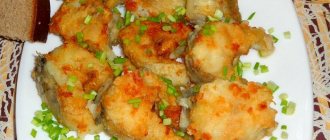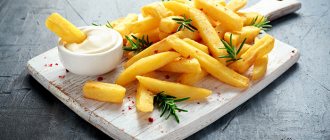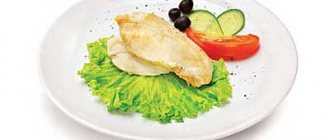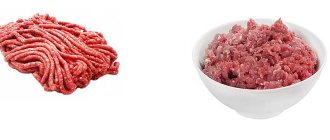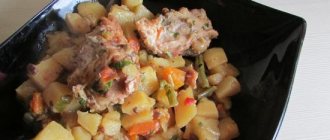Useful properties of pollock
To diversify your diet, include pollock in it. This is a relatively inexpensive fish that contains many useful substances.
Seafood is 99% water and protein. Fat accounts for less than 1%. Pollock also contains potassium, iodine, manganese and numerous vitamins.
Such a rich composition of useful substances allows the use of seafood during the treatment of various ailments and for carrying out preventive measures to prevent them.
Due to the presence of a large amount of vitamin in pollock, it is possible to:
- Help if difficulties arise in the functioning of the heart. Pollock is recommended for consumption if the patient has an arrhythmia;
- Give nails strength and eliminate brittleness;
- Adjust hemoglobin to normal;
- Lose weight.
Normalize hair condition;
The only disadvantage of pollock can be individual intolerance to seafood products, as well as a significant salt content. But if you eat pollock correctly and in moderation, you can maintain health and boost your immune system.
Boil the fish
Doctors strictly recommend giving up fried fish meat and eating only boiled or steamed fish meat. How and for how long to cook it? It is best to take a fresh carcass, but you can also use a fresh frozen one.
If the fish is whole, it is necessary to clean it, dismember it, remove the entrails, and cut it into pieces. Pour water into a saucepan, add salt and spices to taste, boil the water, throw in the fish and cook for about 10 minutes. If you are overweight, then you simply need to eat boiled fish.
Calorie content and BZHU in different types of preparation
This product can be used as one of the dishes while on a diet. And there is a simple explanation for this. Calorie content per 100 grams of product:
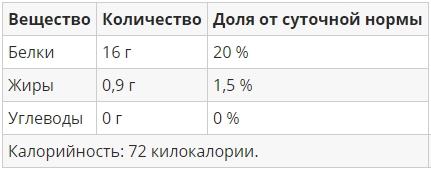
This fish can be prepared in a wide variety of ways, while their taste characteristics and benefits for the body will be at the highest level.
Pollock is usually boiled or steamed. These cooking methods provide low calorie content to the dish. As an experiment, you can fry, stew fish or make cutlets from it.
Pollock is a universal fish that will be equally appropriate for both a regular lunch and a holiday table. At the same time, not only fish fillets can be eaten, but also its liver and eggs. Pollock liver contains 470 kcal per 100 grams, and caviar contains 132 kcal for the same weight of product.

Pollock is a lean fish. To prepare a dish from it, you just need to lightly fry it, adding a small amount of fresh vegetables and herbs. By adding sauce to fish, you can get a chic dish that will appeal to many guests.
Without dredging the fish in flour and simply frying it, the result is a dietary dish. Its calorie content will not exceed 123 kcal per 100 grams. The change in calorie content of the finished dish depends on how much vegetable oil is used during frying. But if you sprinkle the fish in flour, the calorie content will be 137 kcal and will not change, even if you add vegetable oil during frying without restrictions.
Fried seafood is suitable for all categories of people, even those who do not want to fight their excess weight, but simply love fried food. If you don’t want to gain weight when eating pollock, it is better to add greens to the dish, which were previously chopped into small fractions. The dish must be simmered thoroughly.
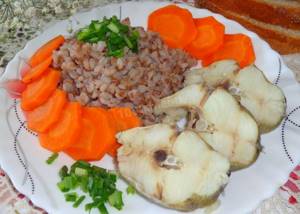
Nutritionists believe that to lose weight you need to eat boiled pollock at least twice a week. This is due to the fact that the calorie content of boiled pollock is 79 kcal per 100 grams. In order for the seafood to bring gastronomic pleasure in addition to helping you lose weight, you need to cook the fish together with onion and bay leaf. To add additional flavor sensations, it is recommended to sprinkle herbs on top of the pieces of fish, and also add thin slices of lemon to them.
The finished product leads to a reduction in cholesterol levels and cleanses the body. The correct way to cook pollock improves memory and leads to faster metabolism. When boiled pollock is consumed, the rate of thyroxine production increases, which leads to an improvement in the general condition of the body.
But in the presence of hypertension and ulcers, eating pollock can lead to negative aspects. Personal intolerance to pollock also harms the body.
The best side dish for boiled pollock is rice or potatoes boiled in their jackets. Fresh vegetables will also be an excellent accompaniment for fish.
To prepare boiled pollock, you should rinse it thoroughly. Next, you need to remove the skin from the fish and cut the carcass along the ridge. Pollock fillet is cut into small pieces. All this is salted and peppered to your taste. Then transfer the pieces of fish into boiling water. Add a medium-sized onion, bay leaf, and lemon zest to hot water. Leave the fish to cook for 20 minutes. After this, we take out pieces of boiled pollock and pour oil on top of it.
Steamed pollock

In order for the fish to retain the entire array of beneficial properties that it contains, you need to cook pollock using steam. To do this, you must follow the cooking recipes exactly. An undoubted advantage of using steam is the separation of fillets from the bones. Under the influence of strong steam, the bones simply fall away. The speed of cooking steamed dishes also differs for the better. The calorie content of such a dish will not exceed 80 kcal per 100 grams of dish.
Thanks to steamed pollock, you can normalize blood sugar, strengthen the immune system, improve the condition of the thyroid gland, speed up the healing process of wounds and strengthen ligaments.
Pollock is an extremely dry type of fish. In this regard, it is necessary to pay careful attention to cooking. This will make the dish extremely tasty. The average calorie content of stewed pollock is only 75 kcal per 100 grams. Even if you add a few onions or carrots, they will make the product only 15 kcal more calories.
Fried pollock, steamed pollock...
In this video, you will be shown how to easily, quickly and very tasty cook fish.
If you smell fried pollock, you know: it will soon be delicious.
There is a stereotype that everything fried is harmful.
Regarding fish, especially pollock, let me disagree. Being one of the most dietary fish, even during frying (but only with the right approach), this fish continues to retain this status.
The calorie content of 100 grams of fried fish in flour will be about 127 kcal, which, of course, is more than in the already mentioned boiled form for obvious reasons.
Frying is a specific process that requires the correct selection of vegetable oil.
You can also prepare cutlets from pollock; their calorie content will be a rather modest figure of 150 kcal per 100 grams.
This component will largely determine which direction the calorie level will go from the average.
Therefore, choose high-quality oil and do not overuse it in the pan.
The result will be influenced by what you use to fry the pollock.
Because if you take sour cream, the calorie content will be 71.7 (almost equal to the calorie content of ordinary raw fish), but the flour and egg batter will give the finished dish as much as 260 kilocalories.
You will be very surprised, but in dried pollock, the calorie content will be approximately 221 kcal per 100 grams.
Pollock fillet cooked in batter will contain 145 kcal per 100 grams of product.
The series of tasty and healthy dishes continues with steamed pollock.
Similar to its boiled relative, steamed pollock will also have an indicator of 80 kcal.
This is explained by the coincidence of the components of the cooking process.
Steaming is recommended to prevent the meat from falling apart, which often happens when boiling.
The most important thing is that pollock, despite the fact that it has a number of useful properties, when prepared by steam processing, has only one contraindication - individual intolerance to fish.
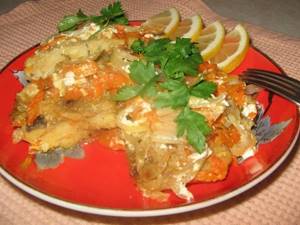
As soon as you open the Internet with a search query about baked pollock, flocks of recipes immediately fly at you.
Baked pollock itself is a completely low-calorie product.
If you don’t invent something like that, you’ll get 75.5 kcal per 100 grams of food.
But adding other ingredients will increase the calorie content.
For example, baked in an omelette will have 83 kcal per 100 grams, but the same volume of pollock flavored with vegetables, sour cream and cheese will give a total of 168 kcal.
Therefore, choose what is better for you: taste or figure?
An excellent culinary solution that combines pleasant taste and an equally pleasant awareness of the benefits of such a dish is stewed pollock.
Just a little over 20 minutes, and your table will be decorated with another fish masterpiece.
It is good and useful in all forms.
Pollock cooked in the oven contains 102 kcal per 100 grams.
So stewed fish has a calorie content of only 77 kcal. As a rule, onions, carrots and other vegetables are stewed together with fish.
Daikon radish, its beneficial properties and cultivation, are described in this article, which contains a lot of interesting information.
Therefore, bon appetit to you, lightness to your stomach and joy to your figure!
Quick answer: the calorie content of boiled pollock is 79 kcal per 100 grams of product. See below for the energy value of fish in other cooking options.
This representative of the cod family is not as popular among chefs as its older brother cod, and in vain! The calorie content of pollock is really very low. And in terms of taste and nutritional qualities, it can give odds to many other types of fish.
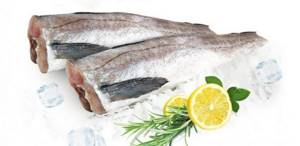
- Ideal fish for losing weight
- Energy value of pollock
- Delicious dietary dishes
- Baked pollock in spicy sauce
- Pollock with vegetables in egg batter
- Pollock baked with carrots and onions
- Pollock in soy sauce
Reviews and results
Stremousova Valeria Evgenievna
Endocrinologist, nutritionist, member of the Russian Association of Endocrinologists
Pollock is a common and affordable species of marine fish of the Cod family. It typically lives and breeds in the great depths of the northeastern Pacific Ocean. Pollock most often comes to our table from Kamchatka, as well as the Atlantic and Norway, both fresh and frozen. In addition, canned food and minced meat are obtained from pollock, which is usually used to make fish cutlets, and it is also smoked and dried.
It is believed that pollock meat is a little dry, so the most acceptable method of cooking for it is stewing, as well as baking with hot seasonings, various vegetables, cheese, herbs and legumes. Pollock is also fried, boiled, steamed and even grilled. This fish can be safely classified as a dietary product, since the calorie content of pollock is low compared to other types of fatty fish.
For those who are worried about their figure, there is good news: there are not many calories in pollock, especially in its boiled version, so it can be safely consumed by those who adhere to a diet or healthy eating principles. When prepared, pollock meat has a delicate, low-fat structure and a neutral taste. It goes especially well with sour cream or cream sauce, but in this case the calorie content of pollock will be slightly higher, so it should be consumed in small quantities.
Delicious dietary dishes
Experts say that it is best to cook pollock using the simplest, most accessible methods, which will only emphasize its pleasant taste and will not add calories.
The taste of the fish is a little dry, so most often housewives prefer to bake it in the oven or stew it with vegetables.
Baked pollock in spicy sauce
For example, for baked pollock in spicy sauce you will need:
- fish fillet - 700 g;
- walnuts - 100 g;
- pickled cucumbers - 2 pcs. (small);
- sour cream - 4 tbsp. l.;
- salt, pepper, fresh herbs - to taste;
- butter - 10 g.
This preparation:
- The fish must be processed, all bones removed, and the fillets cut into medium-sized pieces. The pollock prepared in this way is salted and peppered, then fried in a frying pan in a small amount of oil until golden brown.
- At the same time, the sauce is being prepared. To do this, walnuts, herbs, cucumbers, sour cream and spices are thoroughly ground in a blender.
- The fried fish is laid out on a baking sheet greased with butter and sauce is poured on top.
- The oven should be preheated to 200 degrees. Bake for 25 minutes.
Pollock with vegetables in egg batter
You can also bake pollock with vegetables in egg batter.
- To do this, you need to cut 600-700 grams of fillet into pieces and sprinkle with two tablespoons of lemon juice.
- Then place them in a greased pan.
- On top are three tomatoes cut into circles, sprinkle everything with parsley, salt and pepper. Pour in two beaten chicken eggs.
- Bake for 20-25 minutes in an oven preheated to 200 degrees.
Pollock baked with carrots and onions
For fish baked with carrots and onions, you need:
- pollock - 1 pc. (medium size);
- onion - 1 pc.;
- carrots - 1 pc.;
- sour cream - 50 g;
- salt and pepper - to taste.
Cut the fully processed fish into medium-sized pieces, add salt and pepper. Cut one onion into ring halves, grate the carrots on a coarse grater and place them in layers in a greased form. We put pollock on them.
Pour sour cream and 3-4 tablespoons of boiling water over the fish. Cover the baking dish with foil and place in an oven preheated to 200 degrees for 25-30 minutes.
Pollock in soy sauce
For pollock in soy sauce you need to buy:
- fish - 1 pc.;
- soy sauce - 1 bottle;
- onion - 2 pcs.
This preparation:
- To begin with, the fish is infused in the marinade for half an hour. Thoroughly mix the carcass cut into medium pieces with onion rings, spices and pour soy sauce (150-200 grams).
- Since the sauce itself is quite salty, there is no need to add additional salt.
- After 30 minutes, transfer everything into a baking dish, pour the third part of the marinade there. It is advisable to cover the pan with foil.
- Bake for 30 minutes in an oven preheated to 200 degrees.
Another recipe for pollock with spices will also help brighten up your diet while on a diet. Whole processed fish (its size can reach 45 cm) should be rubbed with salt and pepper. It is sprinkled with 5 grams of dried rosemary on top, poured with a tablespoon of olive oil and sprinkled with the juice of half a lemon. After this, the fish is wrapped in foil and baked in the oven for at least 20 minutes at 150 degrees.
We often see fish like pollock on our dinner table. It is loved by everyone, regardless of the method of preparation - fried or boiled. Where is it found? In the Pacific Ocean, from the Korean Peninsula to the Bering Sea. The Japanese, for example, salt it, dry it and dry it. In our country they also love fish such as pollock. Its calorie content is only 72 kcal. Meat, caviar, and liver are used. Even tails with fins come into play.
How many calories are in pollock? Its composition and beneficial properties
As already mentioned, the calorie content of pollock is low, namely 72 kcal per 100 grams of product. The meat of this fish mainly contains proteins of animal origin (15.9 grams), but there is very little fat in it - about 0.9 grams. Since the calorie content of pollock is low, and the fish itself is quite lean, in order to increase the nutritional value of the product, it is most often flavored with various sauces and gravies, and also served with higher-calorie dishes.
If we talk in detail about the nutritional composition of pollock, then in addition to proteins and fats, 100 grams of the product contains 81.9 grams of water, 0.2 grams of saturated fatty acids, 1.3 grams of ash, and 50 mg of cholesterol. The vitamin and mineral composition of pollock is not very rich, like that of other fish of the Cod family, but nevertheless it contains vitamins A, PP, B1-B9, as well as C and E. Of particular value here is nicotinic acid, which regulates carbohydrate metabolism and It even helps with the early stages of diabetes, liver, stomach and heart diseases.
As for the micro- and macroelements that make up pollock, it contains the most iron, zinc and manganese, as well as potassium, iodine, chlorine, copper, calcium and other substances useful to our body. Thanks to its high fluorine and phosphorus content, pollock, like other types of fish, helps strengthen bones, nails, teeth and hair. But the sodium and potassium in its composition make pollock an excellent antioxidant and assistant for various cardiovascular diseases.
Due to the low calorie content of pollock, it is indicated not only in dietary, but also in baby food. In addition, it is often included in the diet of lactating and pregnant women, as well as the elderly. Due to the low calorie content of pollock in combination with its beneficial composition, nutritionists recommend it as a fish component in weight loss diets. Pollock has no contraindications as such, unless we talk about individual intolerance to the product.
Pollock in dietetics and weight loss
Many diets and nutrition systems include this product and dishes containing it in their menu. Here are just a few of them:
- Protein diet.
- Fish diet, including fasting day.
- Low-carb and no-carb diets.
- Separate meals. Pollock is compatible with green vegetables - both starchy and non-starchy.
- Mono-diet on seafood products. Boiled pollock is recommended as a dinner along with low-fat kefir.
- Weekly diet for weight loss.
Calorie content of pollock depending on the type of cooking
We have just figured out the calorie content of fresh pollock, but how many calories are in pollock, depending on the type of culinary processing? It is known that all dishes and products that are prepared with the addition of oil and other fats have a higher calorie content than steamed or boiled dishes. Therefore, for example, the caloric content of fried pollock will be much higher than the caloric content of boiled pollock, etc.
The calorie content of fried pollock in vegetable oil is about 127 kcal per 100 grams of dish. Boiled pollock has only 79 kcal, and stewed pollock has even less - 75 kcal. If you cook it in batter, then the calorie content will be about 131 kcal, and if the fish is dried, then in this form it will contain 259 kcal per 100 grams. Since the calorie content of fried pollock increases due to the addition of vegetable fats to the fish, it is not recommended to consume it in this form as part of a diet.
Classic steamed pollock
To cook classic steamed fish, you will need:
- pollock carcass;
- salt;
- pepper;
- lemon juice or quarter of a lemon;
- vegetable oil;
- Bay leaf.
Preparation:
These simple ingredients make a flavorful fish that both adults and children enjoy eating. First, wash and remove the carcass from fins, scales, and entrails. Rinse the pollock again under running water and place on a paper towel to absorb excess moisture. The dried and clean carcass should be cut into medium-sized pieces and placed in a glass container, salt and lightly pepper (if you are preparing a dietary dish, it is better to do without pepper at all), sprinkle the pieces with lemon juice. The main thing is not to rush and let the fish absorb the aroma of lemon and pepper; to do this, you need to leave it in a bowl for a quarter of an hour.
Add bay leaf to the steamer water and bring to a boil. Place the pollock when the water is already boiling in the steamer and the aroma of bay leaves has spread throughout the kitchen. In about 15 minutes the fish will be ready.
Simple and tasty recipes for pollock dishes and their calorie content
Fried pollock.
To prepare fried pollock you will need:
- 0.5 kg pollock fillet;
- 2 tbsp. spoons of vegetable oil;
- 2 tbsp. spoons of flour;
- 1 tbsp. spoon of lemon juice;
- salt, pepper to taste;
- 150 grams of canned sea cabbage;
- 2 sprigs of parsley;
- 1 tbsp. spoon of sesame seeds.
Wash the pollock fillet thoroughly, cut into small portions, season with lemon juice, salt and pepper, roll in flour and fry in vegetable oil on both sides. Lightly toast the sesame seeds in a separate frying pan until lightly browned. Place the finished fish on a plate, add a little seaweed, and then sprinkle with herbs and sesame seeds.
The calorie content of this dish will be about 130 kcal per 100 grams.
Pollock with stewed vegetables.
To prepare this dish you will need:
- 0.5 kg pollock fillet;
- 200 grams of carrots;
- 150 grams of onions;
- 1 bell pepper;
- 2 tbsp. spoons of tomato paste;
- herbs, salt, seasonings to taste.
Boil pollock in salted water, then cut into portions. Grate the carrots on a coarse grater, and finely chop the peppers and onions. Stew the vegetables in a cauldron, adding tomato paste, salt and seasonings at the end. Place the vegetables on top of the fish, sprinkling the dish with herbs.
The calorie content of pollock in this case will be about 58 kcal per 100 grams of dish, so this cooking option will certainly please everyone who is losing weight.
A fish meal does not have to be boring, monotonous and predictable. After all, hundreds of delicious and healthy dishes can be prepared from this seafood. The main thing is to choose the right type of fish.
A real find for housewives is pollock. Dry, with a dull taste, it is wonderful in combination with other products, but can pleasantly surprise you when prepared on its own. Undoubtedly, tasty, but is it dietary? What is the calorie content of pollock and can it be included in the menu for those who want to say goodbye to excess weight?
…for good health
You could fill more than one page talking about the health benefits of pollock. And these praises will be justified.
The vitamin and mineral composition of fish is incredibly rich and varied:
- there is almost as much vitamin A in the liver of pollock as in the liver of cod, which means that pollock can support eye health;
- group B has a beneficial effect on the nervous system, is indispensable in the process of tissue regeneration and guards the health of nails, hair and skin;
- vitamin C helps the immune system cope with its difficult daily responsibilities;
- polyunsaturated fatty acids protect the cardiovascular system from disease and fatigue;
- just 100 grams of pollock can provide you with your daily requirement of iodine! But iodine is a healthy thyroid gland, a strong memory, a sharp mind, and a vigorous, cheerful mood;
- chromium contained in pollock fillet helps regulate metabolic processes in the body, which normalizes blood sugar levels, which is why pollock is absolutely necessary for people suffering from diabetes;
- it is noteworthy that 100 grams of fish also contain 150% of the daily requirement of cobalt, which is responsible for metabolism, iron absorption, as well as the processes of hematopoiesis and blood clotting;
- potassium, along with many other substances contained in this fish, protects the heart and cardiovascular system from diseases;
- phosphorus has a great effect on brain activity;
- Finally, fluorine is part of the bones; it is precisely because of its ability to strengthen bone tissue that it is indicated for people with thin and weak bones prone to fractures.
Almost 16 percent of this fish is easily digestible animal protein, while it contains absolutely no carbohydrates. For this property, this fish is loved and appreciated by both professional athletes and those who lead an active lifestyle.
This fish is a real all-rounder. It is notable for the fact that it can be included in the regular weekly menu and can be used to prepare delicate gourmet dishes for the holiday table. Pollock with steamed vegetables will fit into the diet of even the strictest dieter, but fish baked with herbs and aromatic roots in some mind-blowing sauce will easily become the highlight of a romantic dinner.
Fried pollock in batter or flour is an excellent option for a quick family meal, and boiled pollock is a wonderful base for fish aspic. The main thing is to remember that the calorie content of pollock depends entirely on the method of its preparation.
...for the figure
How to cook fish so that the calorie content of pollock is not too high, and the taste of the dish surprises and delights?
You should start from the main figure - 72 kcal per 100 grams. This is exactly the calorie content of fresh pollock. But 100 grams of boiled fillet is already 79 kcal, of course, provided that there is nothing else on your plate except a piece of fish. Herbs and lemon juice will help improve the taste of the finished dish without increasing the number of calories.
The calorie content of steamed pollock is also low - only 80 kcal per 100 grams. Steamed fish is usually tastier than boiled fish, with a more subtle, delicate taste and thick aroma. Pollock prepared in this way will be appreciated by small children and teenage girls who are trying out their first diets.
Fried pollock is a not so dietary dish, but perhaps it has the brightest taste. Energy value of 100 grams is 127 kcal.
However, reducing the calorie content of fried pollock is a more than feasible task. For example, pieces of fish can be fried in wheat flour, not corn flour, as usual, and not in egg batter (in this case, the energy value of the dish will rise to 145 kcal per 100 grams). You can use just a drop of oil for frying or even skip it altogether, preferring a frying pan with a ceramic coating.
But properly and lovingly baked in an egg omelet with vegetables and flavored with sour cream sauce and cheese, pollock may well become the highlight of a family celebration.
True, such a highlight will weigh a lot in terms of energy - 168 kcal per 100 grams. Therefore, it is better not to arrange such feasts of taste for yourself very often.
Pollock is famous not only for its high protein content and lack of carbohydrates. In this article you will find comprehensive information about the calorie content of pollock, and also learn:
- what “medicinal product” contained in pollock will 100% satisfy your daily need for a microelement that promotes weight loss, and why it is beneficial to get it from this particular fish;
- how pollock caviar produces alcohol in the body and why this promotes weight loss;
- why pollock dishes need not be salted, etc.
Pollock in sour cream sauce in a double boiler
Required ingredients:
- pollock – 700 g;
- onions – 2 pcs.;
- sour cream – 150 ml;
- bay leaf – 2-3 pcs.;
- allspice – 2-3 peas;
- lemon – 1 pc.;
- dill – 2-3 sprigs;
- spices and salt - to taste.
Cooking process:
First, rinse the fish under cold water, cut off what is not needed and cut into portions. Peel the onions, chop finely and place in a special steamer bowl.
Add pepper and bay leaf there too. Then place portioned pieces of pollock on the onion. Rinse the lemon, cut into thin slices and place on the fish. Separately, dilute sour cream with spices, add chopped herbs and mix.
Now pour the sour cream sauce over the fish, place the container in a double boiler and cook the fish for forty minutes. After the time has passed, the dish is ready, serve with boiled rice and fresh vegetables.
Calorie content, consumption rate and methods of preparing pollock
The calorie content of pollock is 72 kcal per 100 grams.
Consumption rate
depends greatly on various circumstances, but on average the recommended frequency of eating this healthy seafood product is
2 times a week.
Cooking methods
– traditional for most dishes: boiling, frying, baking, drying, canning, steaming. Depending on the chosen method of heat treatment, the ingredients used and parts of the pollock - caviar, liver or fillet - the calorie content of the resulting dishes will vary.
The calorie content of boiled and steamed pollock is approximately the same.
However, fish that has been boiled in a double boiler does not disintegrate until it is ready, which often happens when the product is boiled in a pan.
And a little about secrets...
The story of one of our readers Alina R.:
I was especially depressed about my weight. I gained a lot, after pregnancy I weighed as much as 3 sumo wrestlers together, namely 92 kg with a height of 165. I thought the belly would go away after giving birth, but no, on the contrary, I began to gain weight. How to cope with hormonal changes and obesity? But nothing disfigures or makes a person look younger than his figure. At the age of 20, I first learned that plump girls are called “WOMAN” and that “they don’t make clothes that size.” Then at the age of 29, divorce from her husband and depression...
But what can you do to lose weight? Laser liposuction surgery? I found out - no less than 5 thousand dollars. Hardware procedures - LPG massage, cavitation, RF lifting, myostimulation? A little more affordable - the course costs from 80 thousand rubles with a nutritionist consultant. You can, of course, try to run on a treadmill until you go crazy.
And when will you find time for all this? And it's still very expensive. Especially now. Therefore, I chose a different method for myself...
Quick answer: the calorie content of boiled pollock is 79 kcal per 100 grams of product. See below for the energy value of fish in other cooking options.
This representative of the cod family is not as popular among chefs as its older brother cod, and in vain! The calorie content of pollock is really very low. And in terms of taste and nutritional qualities, it can give odds to many other types of fish.
Composition and nutritional value
Typically, jelly consists of a thickening component and fruit. Starch most often plays the role of the first. Both dried and fresh fruits or berries can be used as the latter. For example, it could be cherries, cranberries, strawberries, etc.
The calorie content of the finished product per 100 grams depends on the components that make up the drink. Thus, the fewest calories are in jelly made from cranberries, cherries or currants - from 150 to 200 kcal in 1 glass. Milk jelly is considered the most high-calorie - 100 kcal per 100 grams.
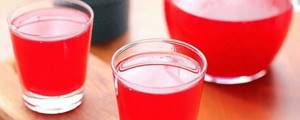
Let's take a closer look at the content of proteins, fats and carbohydrates (BJC) in the dessert. It is believed that jelly contains no proteins or fats (with the exception of milk and flax versions). However, the product contains a large amount of carbohydrates. For example, berry jelly (per 100 grams) contains about 20 grams of carbohydrates, currant jelly - 15 grams, cranberry jelly - 13 grams, cherry jelly - 11 grams.
If you prefer to drink jelly made from concentrate (usually sold in a pack), then know that the dry product contains 87 grams of carbohydrates per 100 grams of powder.
If you prepare jelly yourself at home, it is better to avoid adding sugar to the dessert - this product will significantly increase the calorie content.
Product calorie analysis
Ratio of proteins, fats and carbohydrates:
- Choline is part of lecithin, plays a role in the synthesis and metabolism of phospholipids in the liver, is a source of free methyl groups, and acts as a lipotropic factor.
- Vitamin B12 plays an important role in the metabolism and transformation of amino acids. Folate and vitamin B12 are interconnected vitamins that are involved in hematopoiesis. A lack of vitamin B12 leads to the development of partial or secondary folate deficiency, as well as anemia, leukopenia, and thrombocytopenia.
- Phosphorus takes part in many physiological processes, including energy metabolism, regulates acid-base balance, is part of phospholipids, nucleotides and nucleic acids, and is necessary for the mineralization of bones and teeth. Deficiency leads to anorexia, anemia, and rickets.
- Selenium is an essential element of the antioxidant defense system of the human body, has an immunomodulatory effect, and is involved in the regulation of the action of thyroid hormones. Deficiency leads to Kashin-Beck disease (osteoarthritis with multiple deformities of the joints, spine and limbs), Keshan disease (endemic myocardiopathy), and hereditary thrombasthenia.
more hide
Steamed pollock is prepared from whole pieces of fish, or from clean fillet. For cooking, a double boiler is used, which maintains a certain steam temperature, which makes the product cook slowly, but at the same time retaining more useful properties.
Pollock is rich in vitamins A, PP, K, as well as phosphorus, calcium, iodine and protein. Therefore, it should be consumed for healthy teeth, bones, beautiful hair and healthy skin.
Before steaming pollock, it is necessary to thoroughly rinse and remove skin, mucus and films. Otherwise, an unpleasant bitter taste will appear during the cooking process.
Benefits and harms
Like any other product, jelly has a number of different properties. Some of them are beneficial to the human body, while others cause harm.
Nutritionists and doctors report the following beneficial properties of jelly for humans:
- this dessert has an enveloping effect in the stomach, which helps reduce or even completely eliminate pain in people who suffer from ulcers, gastritis and other gastrointestinal diseases;
- the drink eliminates signs of dysbiosis and tidies up intestinal activity;
- jelly will be an excellent medicine for those who feel heaviness in the stomach after holidays and noisy feasts;
- the product stimulates kidney function;
- the vitamins contained in the product will save you from vitamin deficiency;
- The dish strengthens the immune system and helps strengthen the body's resistance to various infections and viruses.

However, in addition to its beneficial effects, jelly can also have a negative effect on the human body:
- Kissel should not be drunk by people prone to allergies;
- Those who are obese or have extra pounds should also avoid drinking the drink;
- Dessert is contraindicated for people with diabetes.
In addition, you should be careful and careful if you do not prepare the drink yourself, but purchase a special powder preparation. Such a product may contain various chemical additives (for example, dyes, flavors, emulsifiers, sweeteners, etc.). The presence of such harmful components in a store-bought product can cause various skin rashes and disruption of the gastrointestinal tract.

As you have already seen, the drink does not contain as many calories as one might expect. However, this product contains a fairly large amount of carbohydrates (especially if we consider the percentage). That is why it is not recommended to consume jelly for those who adhere to a strict carbohydrate-free diet. For those who do not limit themselves in diet, but still watch calories, it is better to drink this product in the morning rather than in the evening to avoid the appearance of extra pounds.
To learn how to prepare delicious jelly for a flat stomach, see below.
A fish meal does not have to be boring, monotonous and predictable. After all, hundreds of delicious and healthy dishes can be prepared from this seafood. The main thing is to choose the right type of fish.
A real find for housewives is pollock. Dry, with a dull taste, it is wonderful in combination with other products, but can pleasantly surprise you when prepared on its own. Undoubtedly, tasty, but is it dietary? What is the calorie content of pollock and can it be included in the menu for those who want to say goodbye to excess weight?
…for good health
You could fill more than one page talking about the health benefits of pollock. And these praises will be justified.
The vitamin and mineral composition of fish is incredibly rich and varied:
- there is almost as much vitamin A in the liver of pollock as in the liver of cod, which means that pollock can support eye health;
- group B has a beneficial effect on the nervous system, is indispensable in the process of tissue regeneration and guards the health of nails, hair and skin;
- vitamin C helps the immune system cope with its difficult daily responsibilities;
- polyunsaturated fatty acids protect the cardiovascular system from disease and fatigue;
- just 100 grams of pollock can provide you with your daily requirement of iodine! But iodine is a healthy thyroid gland, a strong memory, a sharp mind, and a vigorous, cheerful mood;
- chromium contained in pollock fillet helps regulate metabolic processes in the body, which normalizes blood sugar levels, which is why pollock is absolutely necessary for people suffering from diabetes;
- it is noteworthy that 100 grams of fish also contain 150% of the daily requirement of cobalt, which is responsible for metabolism, iron absorption, as well as the processes of hematopoiesis and blood clotting;
- potassium, along with many other substances contained in this fish, protects the heart and cardiovascular system from diseases;
- phosphorus has a great effect on brain activity;
- Finally, fluorine is part of the bones; it is precisely because of its ability to strengthen bone tissue that it is indicated for people with thin and weak bones prone to fractures.
Almost 16 percent of this fish is easily digestible animal protein, while it contains absolutely no carbohydrates. For this property, this fish is loved and appreciated by both professional athletes and those who lead an active lifestyle.
This fish is a real all-rounder. It is notable for the fact that it can be included in the regular weekly menu and can be used to prepare delicate gourmet dishes for the holiday table. Pollock with steamed vegetables will fit into the diet of even the strictest dieter, but fish baked with herbs and aromatic roots in some mind-blowing sauce will easily become the highlight of a romantic dinner.
Fried pollock in batter or flour is an excellent option for a quick family meal, and boiled pollock is a wonderful base for fish aspic. The main thing is to remember that the calorie content of pollock depends entirely on the method of its preparation.
...for the figure
How to cook fish so that the calorie content of pollock is not too high, and the taste of the dish surprises and delights?
You should start from the main figure - 72 kcal per 100 grams. This is exactly the calorie content of fresh pollock. But 100 grams of boiled fillet is already 79 kcal, of course, provided that there is nothing else on your plate except a piece of fish. Herbs and lemon juice will help improve the taste of the finished dish without increasing the number of calories.
The calorie content of steamed pollock is also low - only 80 kcal per 100 grams. Steamed fish is usually tastier than boiled fish, with a more subtle, delicate taste and thick aroma. Pollock prepared in this way will be appreciated by small children and teenage girls who are trying out their first diets.
Fried pollock is a not so dietary dish, but perhaps it has the brightest taste. Energy value of 100 grams is 127 kcal.
However, reducing the calorie content of fried pollock is a more than feasible task. For example, pieces of fish can be fried in wheat flour, not corn flour, as usual, and not in egg batter (in this case, the energy value of the dish will rise to 145 kcal per 100 grams). You can use just a drop of oil for frying or even skip it altogether, preferring a frying pan with a ceramic coating.
But properly and lovingly baked in an egg omelet with vegetables and flavored with sour cream sauce and cheese, pollock may well become the highlight of a family celebration.
True, such a highlight will weigh a lot in terms of energy - 168 kcal per 100 grams. Therefore, it is better not to arrange such feasts of taste for yourself very often.
Pollock is the most common cod fish in the Pacific Ocean. People have been using it in cooking for a long time. They use fillet, liver, caviar, but some even use tails and fins. Pollock meat contains a small amount of fat, so pollock has small calories.
In the past, it was thought that it was used more often by people with low incomes. But this attitude towards pollock is unjustified. It is due to its unique composition that this fish is included in the menu of sanatoriums. The low calorie content of pollock also plays an important role in dietary nutrition.
Fried pollock. Calorie content, benefits
Most people love to cook and eat this fish fried. In Soviet times, there was no choice in stores; since then I remember that only pollock and hake were on the shelves. But despite the fact that the meat of our fish is tasteless, it was a favorite on every table. Now you can buy this product in almost every store, and they still adore it.
Moreover, if prepared correctly, it will turn out to be quite a tasty dish. Now, by the way, fish lovers are more interested not in the quantity, but in the quality of food. They are interested in the benefits and harms of foods, and count the number of calories to control their weight. And since this fish has now gained popularity again, the question of how many calories fried pollock has is important for many. The calorie content of this fish is 127 kcal per hundred grams of product. So, after eating a couple of pieces of it, you won’t gain weight, but you will get benefits. By the way, one hundred grams of pollock guarantees your daily dose of iodine. Cobalt will regulate lipid and carbohydrate metabolism, promote blood restoration, and activate enzymes.
Composition of pollock
Pollock consists of almost 99% water and protein, which is easily absorbed by the human body.
Fish contains a minimal amount of fat, only 0.9%. This allows pollock to be used in various diets to reduce excess weight. But it is precisely this that contains Omega-3 polyunsaturated fatty acids, which are so necessary for humans. Therefore, despite its low calorie content, pollock copes well with excess cholesterol in the blood.
Pollock has a high iodine content. It must be consumed by people living in areas where there is iodine deficiency in water and soil. It is also indicated for people with certain thyroid diseases;
Pollock meat contains a large amount of vitamins: A, B1, B2, B6, B9, C, E, PP. Fish is rich in minerals: iodine, copper, manganese, potassium, sodium, calcium, magnesium, iron, phosphorus, cobalt, sulfur, chlorine. All this useful composition is due to the fact that pollock is a marine fish.
Chemical composition
Fish contains many valuable substances that take part in the regulation and functioning of the internal organs and systems of the human body.
Table. Chemical composition of pollock.
| Substance | Properties | Amount per 100 grams of fish |
| Vitamin A | Takes part in the regulation of protein synthesis, is necessary for the formation of bones and teeth, accelerates wound healing, slows down the aging process, prevents heart disease, enhances the properties of vitamin C | 10 mcg |
| Vitamin PP | Participates in the production of hormones: thyroxine, insulin and testosterone, normalizes cholesterol levels, prevents the formation of thrombosis | 4.6 mg |
| Vitamin B3 | Improves blood microcirculation, stimulates the production of gastric juice, promotes proper protein absorption, normalizes heart function | 1.3 mg |
| Potassium | In combination with sodium, it regulates water balance in the body, improves oxygen supply to the brain, is necessary for the normal functioning of the endocrine glands, and normalizes heart rate. | 420 mg |
| Sulfur | Participates in the production of collagen, maintains blood sugar levels, has a beneficial effect on the nervous system, improves the condition of hair and nails | 170 mg |
| Phosphorus | Promotes the formation of active forms of vitamins, ensures the growth of dental and bone tissue, maintains their integrity; phosphoric acid is involved in fat metabolism | 240 mg |
| Iron | Catalyzes oxygen exchange processes, supports the functioning of the thyroid gland, promotes normal brain function, and is part of hemoglobin | 0.8 mg |
| Zinc | Participates in enzymatic reactions, ensures the functioning of the immune system, improves visual acuity | 1.12 mg |
| Arginine | Increases testosterone production, improves memory and concentration, removes harmful compounds from liver cells | 1 g |
| Omega-3 fatty acids | Slows down the aging process of the skin, reduces the risk of heart attack and stroke | 0.2 g |
| Omega 6 fatty acids | They regulate blood cholesterol levels, participate in tissue regeneration, and accelerate the healing of skin inflammations. | 0.04 g |
Calorie content of pollock
The calorie content of pollock is about 72 kcal per 100.0 grams of fillet. Compared to other varieties of fish, pollock has, apparently, small calories. The energy value lies mainly in the breakdown of protein into amino acids, so a person receives a small amount of energy. And the calorie content of pollock is small due to the minimal amount of fat.
Due to the small amount of calories, pollock can be used for weight loss. But it should be taken into account that during heavy physical activity, it is necessary to include additional high-calorie foods in the diet, especially if the person is not overweight. It is better to use it on weekends, when the load is light.
The calorie content of pollock, as well as its caviar, is small, and the iodine content is quite sufficient. One serving of this sea fish allows you to almost completely fill a person’s daily need for this microelement.
Modern people are increasingly paying attention not only to the amount of food they eat, but also to its calorie content. Women are especially interested in the question of how many calories are in pollock. The answer largely depends on how the fish is prepared. For example, the average calorie content of fried pollock per 100 g of product is 127 kcal, and that of steamed pollock is significantly less.
Energy value of pollock
It will be difficult to find another product as healthy and nutritious as pollock, which will also have similar fat content.
If you cook pollock with minimal addition of fat, then any finished dish will have low energy value. For example, if you bake fish in foil without adding oil, then the calorie content per 100 grams will be only 77 kcal. And the simplest recipe for cooking pollock is initially designed for a diet.
Not everyone will like boiled fish; many people prefer to fry it. But the calorie content of fried pollock will not be as low as with previous options for its preparation.
- The energy value of fish cooked in oil will be 100 kcal, and if it is rolled in flour or breadcrumbs - 127-135 kcal.
- It’s even tastier to cook fish in batter - 280 kcal.
- Smoked pollock is high-calorie - 195 kcal per 100 grams.
- Some believe that dried fish is dietary, but in fact, in terms of energy value, it leaves far behind other options for its preparation. The calorie content of dried pollock is 220 kcal.
- The situation is much better with dried fish, its energy value is 127 kcal.
You can find canned pollock on store shelves. In each specific case, the calorie content should be clarified by examining the label on the jar, which must indicate the composition of the product. For example, pollock with added oil has an energy value of 149 kcal.
Pollock liver and caviar are also sold as canned food, which should be discussed separately. Despite the general low energy value of fish, its liver is several times more caloric than meat. But this organ is incredibly useful - it contains more than 30% of the same Omega-3 and Omega-6 fatty acids.
Advice from nutritionist Irina Shilina Healthy eating is incompatible with strict dietary restrictions, malnutrition and prolonged fasting. Today there is no need to strive for abnormal thinness by depriving yourself of food! Pay attention to the latest weight loss techniques for 2020. Read more about healthy food and vitamins ->
And although 100 grams of pollock liver contains 475 kcal, you should not immediately cross out the product from your menu. When choosing canned food, pay attention to the composition: they should not contain anything except liver and salt.
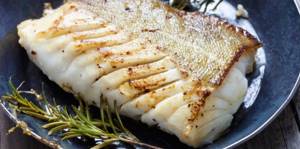
The calorie content of pollock caviar will not be so scary - only 132 kcal per 100 grams. At the same time, the protein content in the same amount reaches 28 grams. But when buying caviar, you must remember that it is contraindicated for hypertensive patients, as well as those suffering from gastritis and peptic ulcers of the gastrointestinal tract.
Pollock fillets or canned pollock fillets are often used to make salads. In these cases, the calorie content always varies, since not only the other ingredients of the dish are important, but also its dressing.
If you use, for example, sour cream, then two spoons of 20 percent dressing will add 86 kcal to the dish. A couple of spoons of mayonnaise will increase the total energy value by 190 kcal. Vegetable oil in two tablespoons already carries 260 kcal.
Useful properties of pollock
Due to the many different beneficial compounds in pollock, it is used for the prevention and treatment of various diseases. In addition, the calorie content of pollock is low, which is so important when following weight loss diets. For example, it is very useful for diseases of the cardiovascular system: coronary artery disease, angina pectoris, myocardial infarction and various types of arrhythmias - all this due to the presence of a sufficient amount of potassium in pollock.
Vitamin A present in pollock promotes normal hair and nail growth. It is also indispensable for the eyes. Due to iron, hemoglobin levels increase.
For the formation of bone tissue and teeth, calcium and phosphorus are needed, which are present in sufficient quantities in pollock meat.
B vitamins, as well as nicotinic acid, cope with the manifestations of dermatitis and polyneuritis. At the same time, you should not worry about the calorie content of pollock when consuming it.
Everyone has long known about the benefits of iodine, which is part of pollock. In 100 g of product its content is up to 150 mcg.
conclusions
It turns out that if you want to eat well, but are worried about possible extra pounds on your body, then it would be nice to remember about a product that has returned to its popularity as a dietary product. This is pollock fish, the calorie content of which will have absolutely no effect on your waistline. Recently, due to complaints from visitors and supporters of healthy eating, the world famous McDonald's restaurant began to indicate calorie content on its dishes. So, it is precisely because of the low calorie content in pollock that this fish is used in the famous fillet-o-fish. In Japan, minced surimi is made from its fillet. So pollock is far from such a simple product.
The product is saturated with vitamins B, PP, A, C, E, chlorine, iodine, calcium, magnesium, zinc, potassium, sulfur, copper.
Calorie content of fried pollock per 100 grams is 137 kcal. 100 g of dish contains 14.7 g of protein, 8.7 g of carbohydrates, 0 g of fat.
The indicated calorie content is relevant for frying a 100-gram portion of the dish in 8 grams of sunflower oil. Accordingly, the more oil is added, the higher the calorie content of fried fish will be.
How many calories are in pollock: pollock for weight loss
The benefits of pollock in weight loss cannot be overestimated. There is no need to count how many calories are in pollock to lose weight. But it should still be taken into account that the calorie content of pollock will depend on the method of its preparation. It is recommended to steam it or eat it boiled. The calorie content of fried pollock is much higher. And although many people like fried fish, including pollock, more than those cooked according to other recipes, you should avoid eating it if you have problems with excess weight.
Pollock fillet in a steamer: a classic recipe with spices
Ingredients:
- Medium-sized pollock – 2 pcs.;
- Lemon juice – 2 tbsp;
- Ground black pepper - to taste;
- Spices for fish - to taste;
- Salt - to taste.
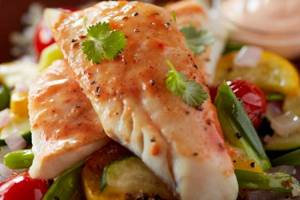
Recipe for cooking pollock fillet in a steamer
- If the pollock is freshly frozen, defrost it.
- We wash it, cut off the head, fins, tail, cut it lengthwise and take out the bones.
- Cut the resulting fillet into portions and place in a container of suitable size.
- Add spices for fish, pepper, salt and lemon juice, mix. Place in the refrigerator for a couple of hours.
- Cook for 15 minutes in a double boiler.
- Serve with fresh vegetable salad.
Stewed pollock
Pollock is a slightly dry fish, so it needs to be cooked properly to create a unique, delicious dish. The average calorie content of stewed pollock is 75 kcal/100 g. If you add some vegetables such as onions and carrots, you will get 90 kcal per 100 g of product.
Stewing seafood can be done with sour cream or mayonnaise, the number of calories will increase slightly to 90 per 100 g. These numbers are small, this seafood can be included in the diet by removing fatty additives.
In order for the stewed fish to turn out tasty and remain rich in vitamins, you must:
- cut and cut fish;
- First fry all the vegetable and other additives;
- pour water or tasty sauce;
- simmer for 45 minutes;
- sprinkle with lemon;
- sprinkle herbs on top.
Stewed pollock is a real find for connoisseurs of low-calorie dishes and lovers of healthy eating.
Easy recipe for stewed pollock
To see how easy it is to prepare this dish, watch the following video:
Ingredients:
- 2 onions;
- 3 cloves of garlic;
- 1 sweet pepper;
- 2 carrots;
- 1 kg pollock fillet;
- 4 tomatoes;
- 240 g cream;
- 300 ml fish broth;
- spices - optional.
Cooking process:
- Fry onions, garlic and carrots.
- Then add and fry the sweet peppers and tomatoes.
- Fill everything with fish broth and lay out the pieces of fish.
- Add cream after the liquid boils.
- Simmer over low heat for 20 minutes.
Pollock fish is a real treasure for people who love to eat delicious food without threatening their beautiful figure. From such fish you can prepare a significant number of dishes for all occasions.
Baked pollock
It is very difficult to imagine a good housewife without an oven and baking foil. Therefore, the simplest and most useful way to cook pollock is baked fish with or without foil. The average calorie content of such an unusual dish is only 85 kcal.
The figure will be more accurate if you count with what and in what the seafood will be cooked. By baking pollock in foil without vegetable oil and other high-calorie additives, we get 75 kcal/100 g. The same figure will be obtained if you bake fish in a sleeve without a side dish.
By adding a variety of vegetables under the foil or in the sleeve, you will get a low-calorie, excellent dish. And cooking with potatoes will add several calories and up to 110 kcal. Cooking pollock along with onions and carrots will increase the number of calories to 104 per 100 g. You can bake fish in sour cream with champignons and get only 85 kcal. If you cook seafood with onions, pouring mayonnaise sauce over everything, you will get a low-calorie dish - 88 kcal per 100 g of product.
We recommend experimenting with various additives, marinades and finding your ideal taste.
Delicious baked pollock with cheese
Ingredients:
- 0.5 kg pollock fillet;
- 3 boiled beets;
- 2 onions;
- 50 g sour cream;
- 50 g grated cheese;
- salt, herbs - optional.
Cooking process:
- Cut the prepared fish fillet into pieces.
- Place seafood, onion rings, and cooked beets into the mold.
- Pour sour cream over everything and sprinkle with cheese.
- Bake for 15 minutes at 200°C.
The benefits of pollock
The undeniable benefits of cooked pollock fish are as follows:
- the product is saturated with fatty acids that help normalize the functioning of the heart muscle and blood vessels;
- with regular consumption of fish, the level of “bad” cholesterol is reduced and the occurrence of cholesterol plaques is prevented;
- the vitamins contained in pollock help restore the energy balance in the body, and due to the low calorie content of pollock per 100 grams, the product is included in the dietary list;
- iodine in pollock is good for thyroid health;
- The properties of pollock to remove waste, toxins, and excess salts from the body have long been known;
- numerous studies have confirmed the benefits of pollock for improving vision, strengthening teeth and bone tissue;
- Fish fatty acids have a calming effect on the nervous system.
Harm to pollock fish
The harmful properties of pollock appear in the following cases:
- In some people, fish causes severe allergic reactions and intolerance;
- pollock is contraindicated for hypertension;
- due to the high salt content in fish, the product should be eaten in very limited quantities by people with high blood pressure;
- You need to control the amount of pollock you eat if you have gastritis or ulcers. In this case, it is recommended not to fry the fish, but to steam or boil it.
When purchasing pollock, be sure to ensure that the skin of the fish is free of damage, a thick layer of ice, and gray or yellowish spots. Such signs indicate that the fish has been frozen more than once.
Pollock fillet: product value

All seafood, without exception, is beneficial for humans. Our body needs nutrients, minerals and vitamins, which pollock fish gives us. The calorie content of this product is not the only quality that attracts supporters of proper and dietary nutrition.
Pollock has a rich component composition. This fish fillet contains the following elements:
- a nicotinic acid;
- cobalt;
- fluorine;
- retinol;
- Omega 3 and 6 acids;
- phosphorus.
Interesting! The concentration of retinol in pollock fillet is much higher than in cod roe or pulp.
Omega-3 and 6 acids are necessary for the human body for the full functioning of the brain. Also, these components have a beneficial effect on the circulatory system and help lower harmful cholesterol levels.
There are practically no contraindications to eating such fish. The only exceptions are allergic reactions. People suffering from gastroenterological ailments will have to postpone their acquaintance with the amazing taste of pollock.
Pollock is very useful for people of various age categories. This fish is even included in the diet of children from an early age. It is easily digestible and does not cause heaviness in the stomach. The main advantage of the fish described is the almost complete absence of fat in it. A large share is due to protein content. Carbohydrates take up very little, and only 1% is fat.
A large amount of vitamins and minerals increases the value of pollock. It must be included in the diet during pregnancy. A high concentration of ascorbic acid strengthens the immune system and triggers fat burning processes. That is why pollock fillet is the basis of the diet of those losing weight.
